Understanding and handling Lewy Body Dementia is crucial for you and your loved ones. This progressive brain disorder exhibits symptoms such as hallucinations, fluctuations in cognition, and movement issues. While there is no cure, treatments focus on managing symptoms through medications and supportive therapies. It is important to establish a regular daily routine and ensure a safe environment. Additionally, effective communication is essential to reduce confusion and emotional distress. Familiarizing yourself with available support resources can greatly assist in this journey. By delving deeper, you will discover strategies that can make navigating this condition easier and more manageable.
Key Takeaways
- Lewy Body Dementia (LBD) involves cognitive fluctuations, visual hallucinations, and movement disorders, requiring comprehensive symptom management.
- Diagnosis of LBD relies on evaluating cognitive and motor functions alongside medical history and imaging studies.
- Treatment focuses on symptom management using cholinesterase inhibitors, while caution is needed with antipsychotic medications.
- Establishing a consistent daily routine and creating a safe environment can significantly improve daily care for individuals with LBD.
- Effective communication strategies, including clear language and emotional validation, enhance interactions and support emotional well-being for those affected.
Overview of Lewy Body Dementia
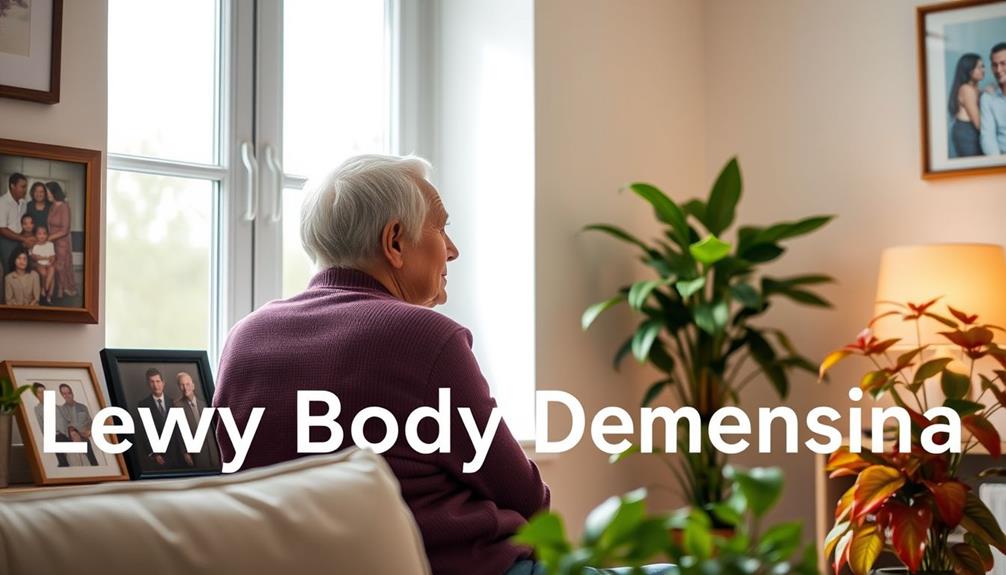
Lewy Body Dementia (LBD) is a complex and progressive brain disorder that affects many aspects of daily life. This condition is characterized by the presence of Lewy bodies, which are abnormal protein deposits disrupting neuronal function.
It's important to note that LBD development is influenced by various biological, cognitive, and social factors, similar to other conditions that affect emotional and psychological growth, as seen in key domains of development.
You might notice that LBD encompasses two primary forms: Dementia with Lewy Bodies (DLB) and Parkinson's Disease Dementia (PDD). In DLB, cognitive symptoms develop within a year of movement issues, while in PDD, cognitive decline happens more than a year after movement symptoms begin.
Common symptoms of LBD include visual hallucinations, which up to 80% of individuals experience, along with fluctuating cognitive function, movement disorders resembling Parkinson's disease, and sleep disturbances like REM sleep behavior disorder.
The diagnosis of LBD is quite complex; it requires a combination of neurological evaluations, cognitive testing, and imaging studies, as there's no single definitive test for the condition.
Currently, there's no cure for LBD. Treatment focuses on managing symptoms through medications such as cholinesterase inhibitors and supportive therapies, aiming to improve your overall quality of life while coping with the challenges the disorder brings.
Causes and Risk Factors
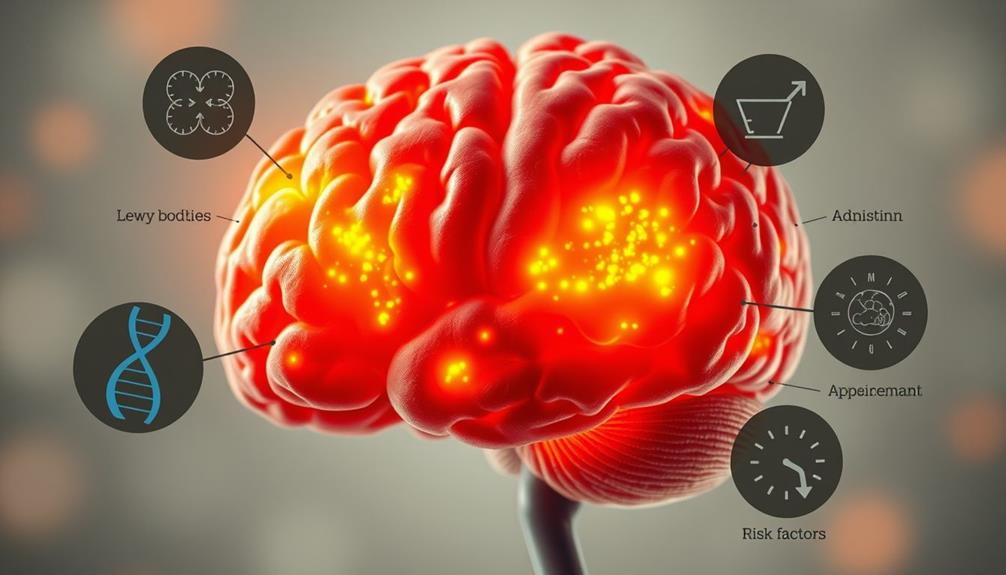
The precise cause of Lewy Body Dementia (LBD) isn't fully understood, but research continues to explore its biological and genetic underpinnings. A key feature of LBD is the accumulation of Lewy bodies, which are abnormal protein deposits that lead to the loss of neurons responsible for producing neurotransmitters like acetylcholine and dopamine. This disruption is thought to play a significant role in the development of Lewy body dementia.
Similar to Borderline Personality Disorder (BPD), LBD may involve complex interactions between genetic, environmental, and neurobiological factors that contribute to its manifestation.
Age is the greatest risk factor for developing LBD, with individuals over 50 being more susceptible. If you or someone you know has a history of Parkinson's disease or REM sleep behavior disorder, these conditions may also increase the risk.
While LBD isn't classified as a genetic disease, having a family history can elevate your risk. Certain gene variants, such as APOE, SNCA, and GBA, have been linked to a higher likelihood of developing LBD.
Understanding these causes and risk factors can help you or your loved ones stay informed and potentially seek early intervention strategies. Awareness is essential in managing this complex condition effectively.
Symptoms of Lewy Body Dementia

When you experience Lewy Body Dementia, you'll notice a range of symptoms that can affect both your cognitive abilities and movement.
Common cognitive changes include fluctuating alertness and confusion, which can be similar to symptoms found in cold medications overview.
Additionally, movement issues may resemble those seen in Parkinson's disease.
Understanding these symptoms is essential for managing the condition effectively.
Common Cognitive Changes
Cognitive changes in Lewy Body Dementia can be unpredictable and challenging, often leading to notable disruptions in daily life. You may notice fluctuations in attention and alertness, which can cause confusion and difficulty concentrating. These cognitive symptoms can vary from day to day, or even within the same day, complicating your ability to manage daily tasks effectively.
Early detection and understanding of cognitive changes are essential, similar to how mammography aims to detect breast cancer early for better treatment outcomes.
Memory decline is another common issue, impacting your ability to perform familiar tasks and maintain daily functioning. As the disease progresses, you might struggle with executive functions, making planning, problem-solving, and decision-making increasingly difficult. This variability in cognitive performance can be frustrating, both for you and your caregivers.
Moreover, up to 80% of individuals with Lewy Body Dementia report experiencing vivid visual hallucinations. These hallucinations can occur early in the disease and greatly affect your quality of life.
It's important to recognize these cognitive changes and discuss them with your healthcare provider. By understanding these symptoms, you can better navigate the complexities of Lewy Body Dementia and seek appropriate support to enhance your daily living.
Movement and Behavioral Issues
Movement and behavioral issues in Lewy Body Dementia (LBD) can considerably impact your daily life, often resembling symptoms of Parkinson's disease. You might experience movement symptoms like bradykinesia, rigidity, and tremors, which complicate daily activities. Additionally, balance problems can increase the risk of falls, making it essential to stay aware of your environment.
Behavioral changes are also significant in LBD. You could encounter visual hallucinations, which affect up to 80% of individuals, often appearing early in the disease. Fluctuating cognition might leave you confused and struggling with attention and alertness.
Moreover, sleep problems, including REM sleep behavior disorder (RBD), can lead to acting out dreams, heightening safety concerns for you and your caregivers. Understanding these challenges is critical for managing LBD effectively.
| Issue | Description |
|---|---|
| Movement Symptoms | Bradykinesia, rigidity, tremors, balance problems |
| Behavioral Changes | Visual hallucinations, delusions, paranoia |
| Fluctuating Cognition | Rapid changes in attention and alertness |
| Sleep Problems | REM sleep behavior disorder, acting out dreams |
| Autonomic Changes | Dizziness, fainting, urinary incontinence |
Diagnosis Process
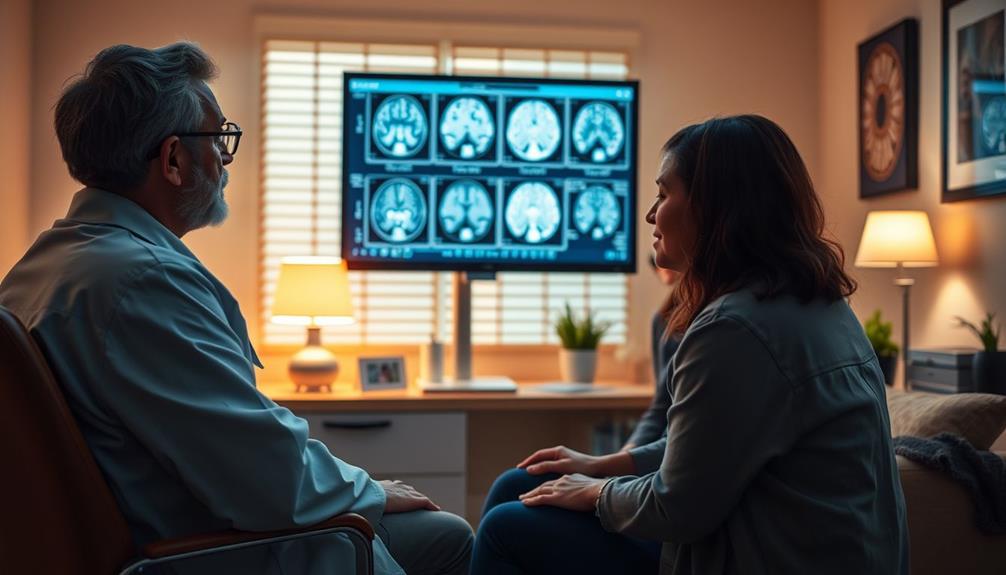
When you're facing the possibility of Lewy Body Dementia, understanding the diagnosis process is essential. The diagnosis typically involves a combination of neurological exams, cognitive testing, and brain imaging, all aimed at distinguishing Lewy Body Dementia from other forms of dementia. Early and accurate diagnosis is crucial in managing symptoms and planning for the future. It’s important to consider the **impact of dementia on families**, as the emotional, financial, and caregiving challenges can be significant, requiring support and resources for both the patient and their loved ones.
You'll undergo symptom evaluation techniques that focus on cognitive decline and other key features like hallucinations and sleep disorders.
It's also important to take into account the implications of medication management for dementia, as dementia medications for the elderly can play a significant role in treatment.
Additionally, diagnostic imaging methods, such as MRI or PET scans, play an important role in confirming the diagnosis and ruling out other conditions.
Symptom Evaluation Techniques
Evaluating symptoms is essential in diagnosing Lewy Body Dementia (LBD), as it involves a thorough review of your medical history and a neurological examination. During this examination, your clinician will assess both cognitive and motor functions to identify specific issues.
Understanding trust issues with boyfriends can shed light on the emotional challenges faced by caregivers, which may impact their observations. The diagnosis of Lewy body dementia typically requires observing a gradual decline in cognitive abilities alongside at least two of the core features: fluctuating cognition, visual hallucinations, REM sleep behavior disorder, and parkinsonism symptoms.
Input from caregivers is invaluable in this process, as they can provide insights into behavioral changes and cognitive fluctuations that may not be apparent in a clinical setting.
Since there's no single definitive test for LBD, it's vital to rule out other forms of dementia, which often requires collaboration between neurologists and psychiatrists. They'll consider the full range of symptoms and their progression to guarantee an accurate diagnosis.
Diagnostic Imaging Methods
Diagnostic imaging methods play an essential role in the diagnosis of Lewy Body Dementia (LBD) by helping to rule out other possible conditions. MRI and CT scans are commonly used to assess brain structure and identify any abnormalities. Additionally, PET scans evaluate brain function and dopamine uptake, offering insights into LBD-related changes.
While imaging tests can suggest types of dementia, they're not definitive for diagnosing LBD. A thorough assessment of symptoms is vital. Neurological exams complement imaging by evaluating reflexes, strength, and cognitive function.
Here's a quick comparison of the imaging methods:
| Imaging Method | Purpose |
|---|---|
| MRI | Assesses brain structure |
| CT | Identifies brain abnormalities |
| PET | Evaluates brain function |
No single imaging test can confirm LBD; instead, the diagnosis relies on a combination of imaging results, clinical evaluations, and detailed medical history. By understanding these diagnostic imaging methods and their role in the process, you'll be better equipped to engage with healthcare providers about your condition or that of a loved one.
Treatment Options
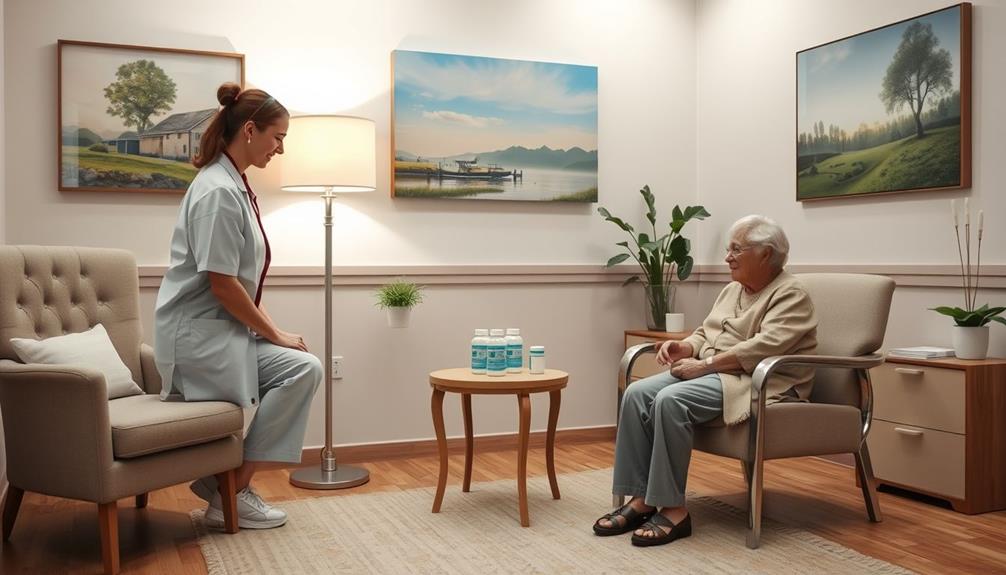
Treating Lewy Body Dementia (LBD) involves a multi-faceted approach aimed at managing symptoms effectively, as there's currently no cure. Your treatment plan should focus on both medications and non-pharmacological interventions to address cognitive and movement-related challenges.
Incorporating alternative therapies, such as aromatherapy with essential oils for symptom relief, can provide additional comfort and support. Cholinesterase inhibitors, like rivastigmine and donepezil, can be beneficial in improving cognitive symptoms and reducing hallucinations. However, be cautious with antipsychotic medications, as they may worsen LBD symptoms, especially in those sensitive to these drugs.
If you're dealing with movement issues, Parkinson's disease medications such as carbidopa-levodopa might help, but keep an eye on any potential confusion they may cause.
Non-pharmacological interventions are essential, too. Engaging in occupational, speech, and physical therapy can greatly enhance daily functioning and quality of life.
Additionally, addressing sleep disorders is important. You can maintain a regular sleep schedule, cut back on caffeine, and, in severe cases, consider medications like clonazepam or melatonin.
Managing Daily Care
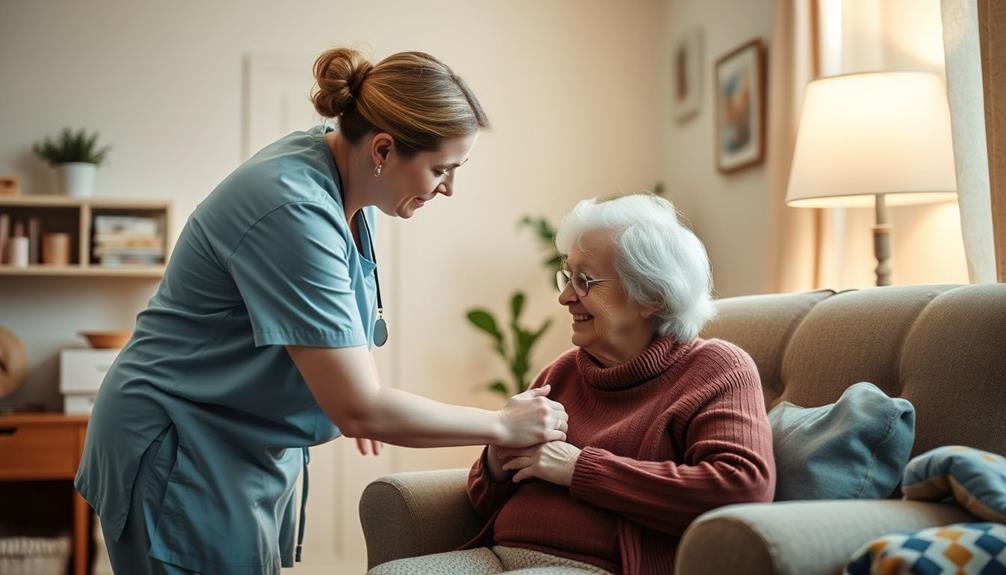
Managing daily care for someone with Lewy Body Dementia (LBD) requires a thoughtful approach that emphasizes routine and safety. Establishing a consistent daily schedule can provide structure, which is vital for managing daily care. Regular monitoring of behavior and cognitive function helps you identify fluctuations that may need adjustments in care strategies.
Creating a safe environment is essential to prevent falls, as movement issues are common. Encouraging participation in activities that stimulate cognitive function, like puzzles or arts, can enhance mental engagement and overall well-being.
Here's a simple guide to help you establish a routine:
| Routine Activity | Purpose |
|---|---|
| Morning Routine | Provides structure to the day |
| Cognitive Activities | Stimulates mental engagement |
| Evening Wind Down | Promotes relaxation and sleep |
Implementing these simple tasks and regular schedules will support daily functioning and reduce confusion, making it easier for your loved one to navigate their day-to-day lives. Remember, the goal is to foster comfort and safety while maintaining the best possible cognitive function.
Research and Clinical Trials
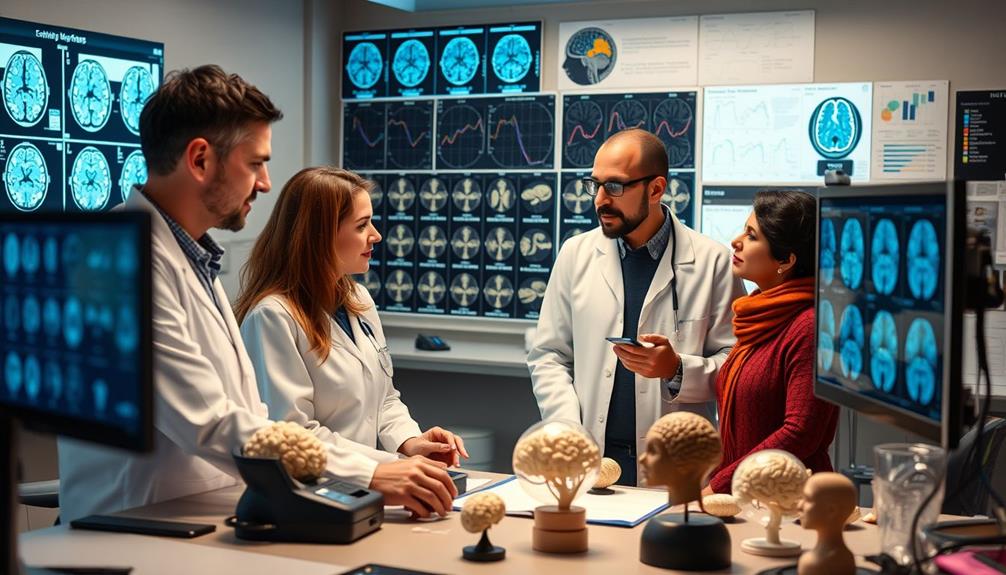
Research into Lewy Body Dementia (LBD) is rapidly advancing, offering hope for early diagnosis and improved treatment options. Ongoing studies focus on identifying genetic, biochemical, and imaging biomarkers that could enhance how we diagnose and treat this complex condition.
Additionally, understanding the financial aspects of healthcare, including budgeting for treatments and financial mistakes to avoid, can empower families facing the challenges of LBD. Clinical trials play a significant role in developing new therapeutic interventions and discovering better diagnostic tools for LBD. Many of these trials actively seek participants, providing an opportunity for individuals with LBD to access cutting-edge treatments.
Participating in clinical trials not only gives you access to innovative therapies but also contributes to valuable data that can improve the understanding and management of LBD. Research is digging into the biological mechanisms underlying LBD, aiming to uncover potential targets for new therapies that could slow disease progression or alleviate symptoms.
For those interested in getting involved, resources from the National Institutes of Health (NIH) and the Alzheimer's Association offer information on current clinical trials and studies related to LBD.
Support Resources

Finding the right support resources can make a significant difference for those affected by Lewy Body Dementia (LBD) and their caregivers. Proper understanding of health conditions, including signs of illness, is essential in managing LBD effectively.
The Lewy Body Dementia Association is a valuable resource, providing caregiver support and a helpline at 404-935-6444 for guidance and assistance. Don't hesitate to reach out for help when you need it.
The National Institute on Aging (NIA) ADEAR Center offers educational materials and publications that enhance your understanding of LBD. These resources can empower you and your loved ones as you navigate this journey.
Additionally, local support groups can be a lifeline, providing emotional and practical assistance. They allow you to share experiences and coping strategies with others facing similar challenges.
If you're looking for specific local services, the Eldercare Locator at 800-677-1116 can help you find resources tailored to your needs.
Online forums and communities also offer an excellent opportunity for caregivers to connect, share resources, and gain support. By utilizing these support resources, you can better manage the complexities of LBD and improve your overall well-being.
Communication Strategies

When communicating with someone who's Lewy Body Dementia, using clear and simple language is key to reducing confusion.
Incorporating heartfelt expressions of love can enhance emotional connection and understanding.
Non-verbal cues, like gestures and maintaining eye contact, can enhance understanding and connection.
It's also important to validate their feelings, as this can promote emotional well-being and ease frustration.
Simplified Language Use
Using simple and clear language is key to effectively communicating with individuals who've Lewy Body Dementia (LBD). This approach enhances understanding and reduces confusion during conversations. When you speak, use short sentences and straightforward words. This helps guarantee that the individual grasps your message without feeling overwhelmed.
Maintaining eye contact is essential too. It fosters connection and makes the interaction feel more personal. Remember, individuals with LBD may need extra time to process information and articulate their thoughts, so allow for pauses in the conversation. Patience is critical.
Incorporating visual aids or gestures can greatly support your communication. These tools provide additional context and help the individual understand your words better.
Always validate their emotions and feelings, acknowledging their experiences to promote dignity and respect. This not only enhances communication but also reinforces their sense of self-worth.
Non-Verbal Communication Techniques
Non-verbal communication techniques play an essential role in interactions with individuals who have Lewy Body Dementia (LBD). These strategies enhance understanding and connection, making communication smoother. Maintaining eye contact is one effective method; it fosters engagement and helps convey emotions. You can also use visual aids, gestures, and simple pictures to clarify messages and reduce confusion.
Here's a quick overview of effective non-verbal communication techniques:
| Technique | Purpose | Example |
|---|---|---|
| Eye Contact | Enhances engagement | Look into their eyes |
| Visual Aids | Supports verbal communication | Show a picture of a routine |
| Consistent Routine | Provides structure and security | Use familiar cues daily |
Emotional Validation Importance
Emotional validation is vital in your interactions with individuals who've Lewy Body Dementia (LBD). Acknowledging and accepting their feelings can greatly reduce the confusion and fear they often experience. When you validate their emotions, you help maintain their dignity and self-respect, fostering a sense of connection and trust in your communication.
As a caregiver, it's important to listen actively and respond empathetically. Avoid arguing or dismissing feelings; instead, show that you understand their emotions. This approach promotes emotional well-being and strengthens your relationship.
Use clear and simple language while maintaining eye contact to enhance communication effectiveness. This way, individuals with LBD feel truly understood and supported.
Incorporating visual aids or gestures can be beneficial, too. These tools can complement your verbal communication, helping to express understanding and validate their feelings more effectively.
Preparing for Emergencies

When preparing for emergencies, it is vital to have all necessary health information readily accessible. This means keeping an updated list of medications, dosages, and health conditions, including any allergies. You should also have copies of your health care advance directives, like living wills, on hand to guide medical decisions.
Creating a medical alert card can also be a lifesaver. It should include critical health information and contact details for healthcare providers, family, and friends. Store your health insurance cards and emergency contact information in a designated spot, so you can retrieve them quickly when needed.
Regularly reviewing and practicing your emergency plans with caregivers and family members guarantees that everyone knows the procedures and resources available.
Here's a quick reference table to help you organize this information:
| Item | Details |
|---|---|
| Medications | List with dosages |
| Health Conditions | Include allergies |
| Health Care Advance Directives | Living wills and copies |
| Emergency Contact Information | Family and friends' numbers |
| Medical Alert Card | Critical health details |
Frequently Asked Questions
How to Handle Someone With Lewy Body Dementia?
When handling someone with Lewy Body Dementia, use clear language, maintain eye contact, and establish a routine. Monitor their behaviors closely, validate their feelings, and involve a care team for tailored support. When handling someone with Lewy Body Dementia, use clear language, maintain eye contact, and establish a routine. Monitor their behaviors closely, validate their feelings, and involve a care team for tailored support. It’s important to remain patient and empathetic while addressing some of the top challenging dementia behaviors, such as hallucinations, delusions, or agitation. Providing a calm and structured environment can help reduce distress and reinforce a sense of safety and stability. Engaging in activities that bring comfort and joy can also positively impact their well-being.
What Should People With Lewy Body Dementia Avoid?
You should avoid antipsychotics, caffeine, and large meals before bed. You'll want to steer clear of overstimulating environments, sudden changes, and medications that cloud your mind. These actions can help maintain clarity and comfort.
What Activities Are Good for Lewy Body Dementia?
Engaging in regular physical exercise, cognitive stimulation activities, and social interactions can greatly benefit you. Consider gardening or cooking for routine, and try relaxation techniques to enhance your emotional health and overall well-being.
How to Slow Down Lewy Body Dementia?
To slow down cognitive decline, you should engage in regular exercise, stimulate your mind with puzzles, maintain a consistent routine, socialize with others, and eat a balanced diet rich in antioxidants and omega-3 fatty acids.
Conclusion
In understanding and managing Lewy Body Dementia, you're taking an essential step toward improving the quality of life for those affected. With awareness of the symptoms and available treatments, you can make informed decisions and seek support. Isn't it comforting to know that resources and strategies exist to help navigate this journey? By staying proactive, you can foster a supportive environment that enhances communication and care, ensuring that both patients and caregivers feel understood and empowered.









